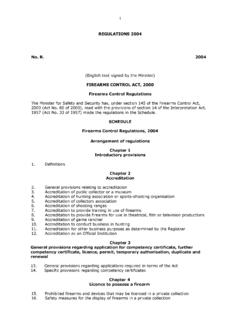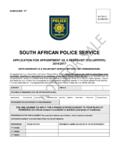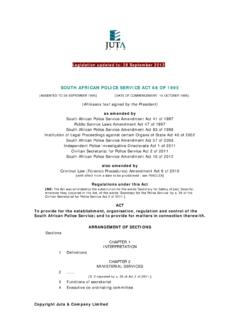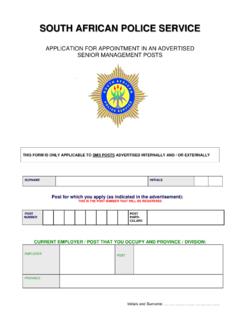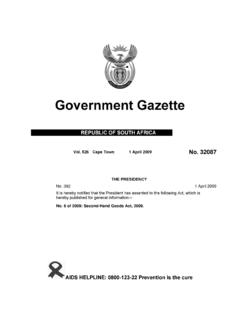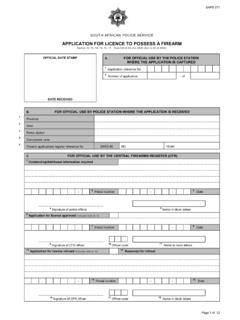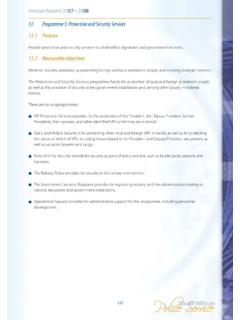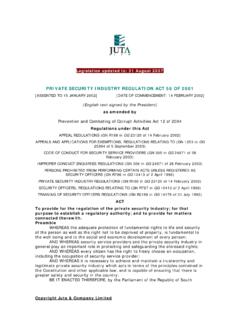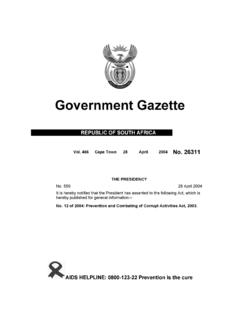Transcription of VC 9088 COMPULSORY SPECIFICATION FOR SMALL ARMS …
1 1 VC 9088 COMPULSORY SPECIFICATION FOR SMALL arms SHOOTING RANGES 1 Scope This SPECIFICATION covers general requirements for the planning, construction and operation of indoor and outdoor shooting ranges. It does not apply to any area where it could otherwise be lawful to discharge a firearm. 2 Definitions For the purpose of this SPECIFICATION the following definitions apply: backplate the steel plate covering the area of the protected zone (qv) of an indoor range, behind and around the bullet trap (qv), where bullet strikes are likely. It has no direct equivalent on an outdoor range. baffle a structure or device, that is mounted with its face towards the firing point (qv).
2 It is intended to stop or redirect misdirected shots. bullet trap/catcher the device or construction behind the targets intended to stop and trap shots that pass through or near the targets. danger area the fan shaped area beyond the targets where those misdirected shots that do not impact the stop butt (qv), either in azimuth or elevation, will impact. A danger area is not required if the stop butt is of sufficient size. NOTE Only outdoor ranges can have a danger area. firing point the point, or points, from which shots may be fired on the range. full bore centre fire cartridges and firearms so chambered.
3 Protected zone the area of an indoor range, behind and around the Bullet Trap (qv) and Backplate (qv), intended to stop all misdirected shots that may reasonably be expected to be fired. Depending on the dimensions of the range it may include parts of the sidewalls and ceiling. Analogous to the stop butt (qv) on an outdoor range. 2 ricochet a bullet that continues to travel through the air after rebounding or skipping off some object or part of the range. safety angle the required minimum angle between the sighting line (qv) and an imaginary line drawn from the eye of the shooter to the top or side of the stop butt (qv) or protected zone (qv).
4 SMALL arms handguns, rifles and shotguns. SMALL bore the 0,22 inches rim fire cartridge and firearms so chambered. sighting line an imaginary line drawn from the eye of the shooter to the target. stop butt /back stop the bank, wall or other device, behind and around the bullet trap (qv), intended to stop all misdirected shots that may reasonably be expected to be fired. It applies only to outdoor ranges. 3 Categories of ranges General There are three basic categories of shooting ranges: a) indoor ranges (see Annex B), b) Outdoor no danger area ranges (see Annex C), and c) Outdoor danger area ranges (see Annex D).
5 NOTE There is no essential difference between handgun and rifle ranges. However, the much higher velocities and muzzle energies of most rifle ammunition impose greater demands on the bullet trap, protected zone or stop butt, and danger area of the range. The use of a range for centre fire rifle, in addition to handgun, will often be dependant on the economics of the necessary construction and/or the danger area available. indoor ranges indoor range is a range that is constructed inside a building. Outdoor no danger area ranges A no danger area outdoor range shall be constructed or designed in such a way that no misdirected shot, that can reasonably be expected to be fired towards the targets, will leave the range.
6 Outdoor danger area ranges Outdoor danger area ranges are ranges where the stop butt (only outdoor ranges can have danger areas) is not sufficiently high and/or wide to meet the requirement to contain all reasonably expected misdirected shots. Outdoor danger area ranges shall have a danger area (see figure 1) beyond the stop butt. In the case of shotgun ranges there is no stop butt, and the danger area then naturally is the area where all the shot impacts. 4 Potential hazards associated with shooting ranges indoor range potential hazards The following potential hazards should be taken into consideration when designing and constructing a shooting range: a) Bullets striking some part of the range other than the bullet trap and ricocheting so as to pose a hazard to shooters or a third party.
7 B) Splashback of particles from target frames, bullet trap or any other item within the protected zone. c) Noise from the discharge of the firearm damaging shooters' hearing. d) Noxious fumes from the propellant gases. e) Lead dust and particles from unjacketed bullets. f) Risk of fire from dust build-up and from tracer ammunition. g) Ejected cartridge cases or gas and propellant particles striking an adjacent shooter. h) Inadequate lighting affecting the shooter's ability to see clearly the sights and targets. i) Incorrect usage of the range. Outdoor range potential hazards The following potential hazards should be taken into consideration when designing and constructing a shooting range: a) Bullets missing the stop butt and leaving the range.
8 B) Bullets striking some part of the range other than the stop butt and ricocheting so as to miss the stop butt, and thus leaving the range. c) Splashback of particles from target frames, bullet trap or stop butt. d) Noise from the discharge of the firearm damaging shooters' hearing. e) Ejected cartridge cases or gas and propellant particles striking an adjacent shooter. f) Glare from the sun affecting the shooter's ability to see clearly the sights and targets. g) People entering the danger area, or into the range itself. h) Incorrect usage of the range. i) Any extraordinary hazards low flying aircraft from a nearby airfield.
9 4 5 Distances over which ammunition is dangerous When designing a range the maximum range distances should be taken into consideration, see Annex A. NOTE - SMALL arms projectiles will travel a considerable distance when fired at a slight elevation angle. 6 Range construction Stop butt or protected zone The range shall have a stop butt, or protected zone in the case of an indoor range. This shall be of such a height and width that it will intercept any shot that can reasonably be expected to be fired in the general direction of the targets and bullet trap. For this purpose the top of the stop butt/protected zone shall subtend a safety angle of 80 (vertical) from the sighting line, as seen from the firing points and the ends of the stop butt (horizontal), 120 (see figure 2).
10 The stop butt/protected zone shall, in addition, be of thickness and material that bullets will not penetrate. It shall not cause ricochets or splashback of bullets or pieces of bullet. The size of the stop butt/protected zone will depend on the length of the range from rearmost firing point to targets, the distance between targets and stop butt/protected zone, the width of the firing point and the height or heights above the ground (or range floor) that shooting takes place (prone or standing shooting, etc) and will incorporate a vertical safety angle of at least 80 to the firing point. Specific requirements for different types of ranges are given in annexes B, C, D and E.
